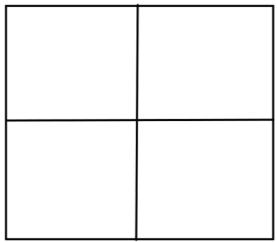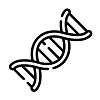9.4: Codominance, Multiple Alleles, and Incomplete Dominance
- Page ID
- 133681
\( \newcommand{\vecs}[1]{\overset { \scriptstyle \rightharpoonup} {\mathbf{#1}} } \)
\( \newcommand{\vecd}[1]{\overset{-\!-\!\rightharpoonup}{\vphantom{a}\smash {#1}}} \)
\( \newcommand{\id}{\mathrm{id}}\) \( \newcommand{\Span}{\mathrm{span}}\)
( \newcommand{\kernel}{\mathrm{null}\,}\) \( \newcommand{\range}{\mathrm{range}\,}\)
\( \newcommand{\RealPart}{\mathrm{Re}}\) \( \newcommand{\ImaginaryPart}{\mathrm{Im}}\)
\( \newcommand{\Argument}{\mathrm{Arg}}\) \( \newcommand{\norm}[1]{\| #1 \|}\)
\( \newcommand{\inner}[2]{\langle #1, #2 \rangle}\)
\( \newcommand{\Span}{\mathrm{span}}\)
\( \newcommand{\id}{\mathrm{id}}\)
\( \newcommand{\Span}{\mathrm{span}}\)
\( \newcommand{\kernel}{\mathrm{null}\,}\)
\( \newcommand{\range}{\mathrm{range}\,}\)
\( \newcommand{\RealPart}{\mathrm{Re}}\)
\( \newcommand{\ImaginaryPart}{\mathrm{Im}}\)
\( \newcommand{\Argument}{\mathrm{Arg}}\)
\( \newcommand{\norm}[1]{\| #1 \|}\)
\( \newcommand{\inner}[2]{\langle #1, #2 \rangle}\)
\( \newcommand{\Span}{\mathrm{span}}\) \( \newcommand{\AA}{\unicode[.8,0]{x212B}}\)
\( \newcommand{\vectorA}[1]{\vec{#1}} % arrow\)
\( \newcommand{\vectorAt}[1]{\vec{\text{#1}}} % arrow\)
\( \newcommand{\vectorB}[1]{\overset { \scriptstyle \rightharpoonup} {\mathbf{#1}} } \)
\( \newcommand{\vectorC}[1]{\textbf{#1}} \)
\( \newcommand{\vectorD}[1]{\overrightarrow{#1}} \)
\( \newcommand{\vectorDt}[1]{\overrightarrow{\text{#1}}} \)
\( \newcommand{\vectE}[1]{\overset{-\!-\!\rightharpoonup}{\vphantom{a}\smash{\mathbf {#1}}}} \)
\( \newcommand{\vecs}[1]{\overset { \scriptstyle \rightharpoonup} {\mathbf{#1}} } \)
\( \newcommand{\vecd}[1]{\overset{-\!-\!\rightharpoonup}{\vphantom{a}\smash {#1}}} \)
In the previous exercises, we treated every trait the same -- that there were only two possible alleles for a trait, with one of those alleles being dominant and the other recessive. However, this is not always the case. Sometimes the heterozygotes show a third phenotype due to incomplete dominance or codominance and sometimes there are more than two alleles for a trait in a population.
Multiple Alleles and Codominance
Human blood types provide an excellent example of multiple alleles and codominance. In the human population, there are three possible alleles: \(I^A\) (type A), \(I^B\) (type B), and i (type O). \(I^A\) and \(I^B\) are both shown with capital letters because they are both dominant to i and the superscript A and B are used because IA and IB are codominant to each other. Since they are codominant, someone with the genotype \(I^A\)\(I^B\) would have type AB blood.
Using the information above, determine the blood type of each genotype below.
- \(I^A\)\(I^A\) : __________
- \(I^B\)i: ___________
- \(I^A\)\(I^B\) : __________
- ii: ____________
Now let’s apply this knowledge to the following scenario.
Julia grew up not knowing who her biological father is. Her mother, Mary, did not tell her before Mary passed away. Julia knows her own blood type, her mother’s blood type, as well as the two possible fathers (Larry and David) and their blood types. The table below contains this information. You will then use this information to fill in the blanks of the table and ultimately help Julia figure out who her biological father is.
| Julia | Mary | Larry | David | |
|---|---|---|---|---|
| Blood Type | Type O | Type O | Type AB | Type A |
| Possible Genotype(s) | ||||
| Are They the Father? | ||||
Incomplete Dominance
Incomplete dominance occurs when neither allele can “mask” the other. Instead, the heterozygotes’ alleles create a third phenotype that appears to be a blend of the two. So for example, if there is a straight hair allele and curly hair allele, then the heterozygote would have wavy hair as wavy hair would be “in between'' straight and curly. Since neither allele is dominant, capital letters with superscripts are used to show each allele as seen in the table below.
| Homozygous (Straight) | Heterozygous (Wavy) | Homozygous (Curly) |
|---|---|---|
| \(H^SH^S\) | \(H^SH^C\) | \(H^CH^C\) |
For this exercise on incomplete dominance, we will look at flower color. There are two alleles for flower color in this example: CR , which encodes for red flowers, and CW which encodes for white flowers. In the table below, fill in the blanks and then complete the Punnett squares for the given cross. Once you completed the Punnett squares, color in the squares with the correct phenotype/flower color.
| Genotype | \(C^RC^R\) | \(C^RC^W\) | \(C^WC^W\) |
|---|---|---|---|
| Flower Color |
Cross: \(C^RC^R \times C^WC^W\)

Cross: \(C^RC^W \times C^RC^W\)



